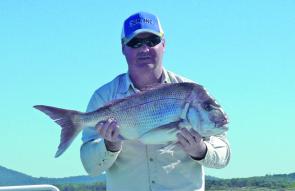I have always tried to be a glass half full kind of person. But the weather in the Clarence Valley over the past six months has been enough test any angler’s resolve. We had a flood in February followed by several, smaller freshes and now another flood of almost biblical proportions.
I am told the floodwater in Yamba reached into areas that have never been flooded in record keeping history and that Palmers Island recorded heights above the benchmark 1974 flood. Fortunately the pressure valve was freed on Maclean as the tide turned at the river mouth and spared us from a disastrous flood in the main centre of town.
But a resilient angler will always find a way to use the conditions to their advantage, which is exactly what has been happening on the Clarence.
Fish actually don’t rely on eyesight as much as we think, so the dirty floodwater makes it a good time to target mulloway and bream. In the estuaries these species welcome all that dirty water and use it as a time to gorge themselves on easy pickings.
The thinking fisherman will also recognise that it’s at this time these fish are at the most vulnerable because they will have their guards down. Use hardbody lures with rattles in them, vibration blades or live bait to target these fish while the water is dirty. Soft plastics and dead baits also seem to catch more than their fair share of catfish in the Clarence during times of dirty water.
The savvy angler will know to fish just ahead of pending floodwaters too, as predatory fish will actually make their way upstream to meet all the prawns and bait fish being flushed out of the system. Why would the fish wait at the river mouth when you can fill up on food on the way down?
Funny things occur during floods; this time anglers anxious to get amongst the flood time mulloway were pleasantly surprised to find bass actually feeding on prawns in the corner of Turners beach at Yamba. That's right, beach fishing for bass, and several respectable sized fish were caught as well.
Bream really do quite well out of floods, they will chase the prawns to sea and spend a few weeks feeding on them on the back of beaches. As the salt pushes back up river the bream return in much better condition than when they left. Many confuse them with snowy bream as these residents put on condition and turn very silver from the pure salt water.
July will see the salt water making its way well back up river. The fish will be congregated in fairly specific areas. Work the front edge of run-in tides for the best results, with some very memorable fishing sessions up for grabs.
The lizards will also be around in good numbers up in the Broadwater in July, so look for the smaller run-out tide, turning on daybreak for best results.
The snapper were just starting to warm up for the soft plastic throwers. Some of my customers were having good early results on close in reefs when the flood came, which was a small setback but I am hopeful the offshore water will clear quickly. July should then see us in the thick of a great snapper run.
Past years indicate after a major flood the bass fish very well in spring and summer, let's hope this year is no exception.
The must-have new cutting edge fishing toy is the new Daiwa Tournament Master Z interline rod series. I must admit, when my Daiwa sales rep first told me of their pending release, I faked excitement! Daiwa Interline rods are certainly nothing new, several models have come and gone without really capturing the imagination of the angling public, and I initially thought they were flogging dead horse.
The recreational fishing industry is constantly evolving, and there is always a risk of being left behind. I believe these new Interline rods are actually a case of the future catching up with the past.
A problem for everybody who uses ultra light braids is that manufacturers are constantly developing even thinner lines. While they are fantastic to fish with, they do pose a few problems. The finer the braid, the quicker it leaves the reel and the more chance of over runs in guides. And the longer or thicker the leader, the worse it becomes. So it makes good sense to just get rid of the guides!
It is early days yet but if these rods are as good as our early results have shown, I think they will become the standard that others rods will be judged by. In 26 hours of casting between myself and another staff member we didn’t have one single tangle! Some 20 hours of this experiment the lovely but volatile Sunline 6lb Rock Fish was used.
The other benefit of Daiwa’s latest rod is that tangles caused by loose loops being pulled from under the top layers of line off the reel seem to be non-existent. Anyone who finesse fishes soft plastics will know that loose loops are caused by picking up slack line after hopping you soft plastic. It would appear that the tension of the braid coming back through center of the blank has gone a long way to resolve this problem as well.
The jury is out on the Daiwa Tournament Master Z casting further than normal guided rods, but I can tell you that they cast every bit as well.
For more information, country service and city prices, call us at Big River Bait & Tackle on (02) 6645 1834.
Reads: 3549
William Duncan with a Shake-n-Bake caught middle wall bream, making it's way back home after a fresh.

Ritchie Duncan with his PB lizard - smack on 99cm.

The author with a massive inshore red.




